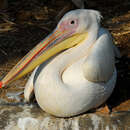en
names in breadcrumbs


Perception Channels: visual ; tactile ; acoustic ; chemical
Large African population of approximately 75,000 pairs. Not globally threatened, although this species is declining slightly in Europe (Danube Delta) due to human activity.
Family Pelecanidae contains 1 genus, 7 species, 12 taxa. Two species are threatened, but none have gone extinct since early 17th century. The family inhabits all regions except Antarctica.
IUCN Red List of Threatened Species: least concern
May eat some commercially important fish, but generally this pelican eats non-commercial fish such as shoalfish and cichlids.
Pouch has been used for tobacco pouches and sheaths. Young pelicans are prized for fat; the oils derived from pelican fat are used for medicine in China and India (to fight rheumatism).
Pelican feathers and skin are used to make leather. Excrement makes for good, cheap fertilizer in third world countries.
Primarily eats fish. In Europe, prefers carp; in Africa, prefers cichlids. Large fish make up 90% of the Great White Pelican diet. The other 10% includes abundant small fish, and, in SW Africa, eggs and chicks of the Cape Cormorant (Phalacrocorax capensis). Estimated daily food requirement of 900-1200 grams (or 2-4 large fish). Feeds in groups, often cooperatively--this is rare among birds. In cooperative feeding, 8-12 pelicans get in a horseshoe formation on the water; they surround and force fish into shallow water, flapping wings and plunging bills to catch the fish along the way. When it catches a fish, the pelican tilts its bill up and swallows the fish whole.
Eastern Europe (Danube Delta) east to Western Mongolia. Migrates to winter in NE Africa and Iraq east to N India (Sept.-Feb.). Also year-round populations in Africa (south of the Sahara Desert). Single sites in NW India and
S Viet Nam.
Biogeographic Regions: palearctic (Native ); ethiopian (Native )
In Europe, the habitat includes freshwater lakes, deltas, marshes, or swamps; that is, wherever sufficient amounts of reedbeds or grasses exist for nesting. In Africa, the habitat includes lowlands and alkaline or freshwater lakes. This pelican's fishing technique demands shallow, warm water.
Terrestrial Biomes: savanna or grassland
Aquatic Biomes: lakes and ponds; rivers and streams; coastal
Average lifespan
Status: captivity: 51.0 years.
White, wing feathers black, large bill colored bright yellow and blue and tipped with red, pouch and feet yellow.
Male: 175 cm long; 9-15 kg; bill is 347-471 mm long.
Female: 148 cm long; 5-9 kg; bill is 289-400 mm long.
Average wingspan: 226-360 cm.
Range mass: 5000 to 9000 g.
Other Physical Features: endothermic ; bilateral symmetry
Breeding occurs in spring in temperate zones of Europe; all year round in Africa. This pelican breeds as it lives, in a large colony near water. Male courting behavior includes a display of vivid colors on the gular pouch and a moulted crest. Pair formation, nest site selection, and nest building occurs rapidly (few hours to no more than a week). The nest is on the ground and consists of either a pile of sticks or little more than bare rock. This pelican averages two eggs; incubation of 29-36 days; fledging at 65-75 days. Breeding success rate of .64 chicks per attempt. Sexual maturity at 3-4 years.
Key Reproductive Features: iteroparous ; gonochoric/gonochoristic/dioecious (sexes separate); sexual ; oviparous